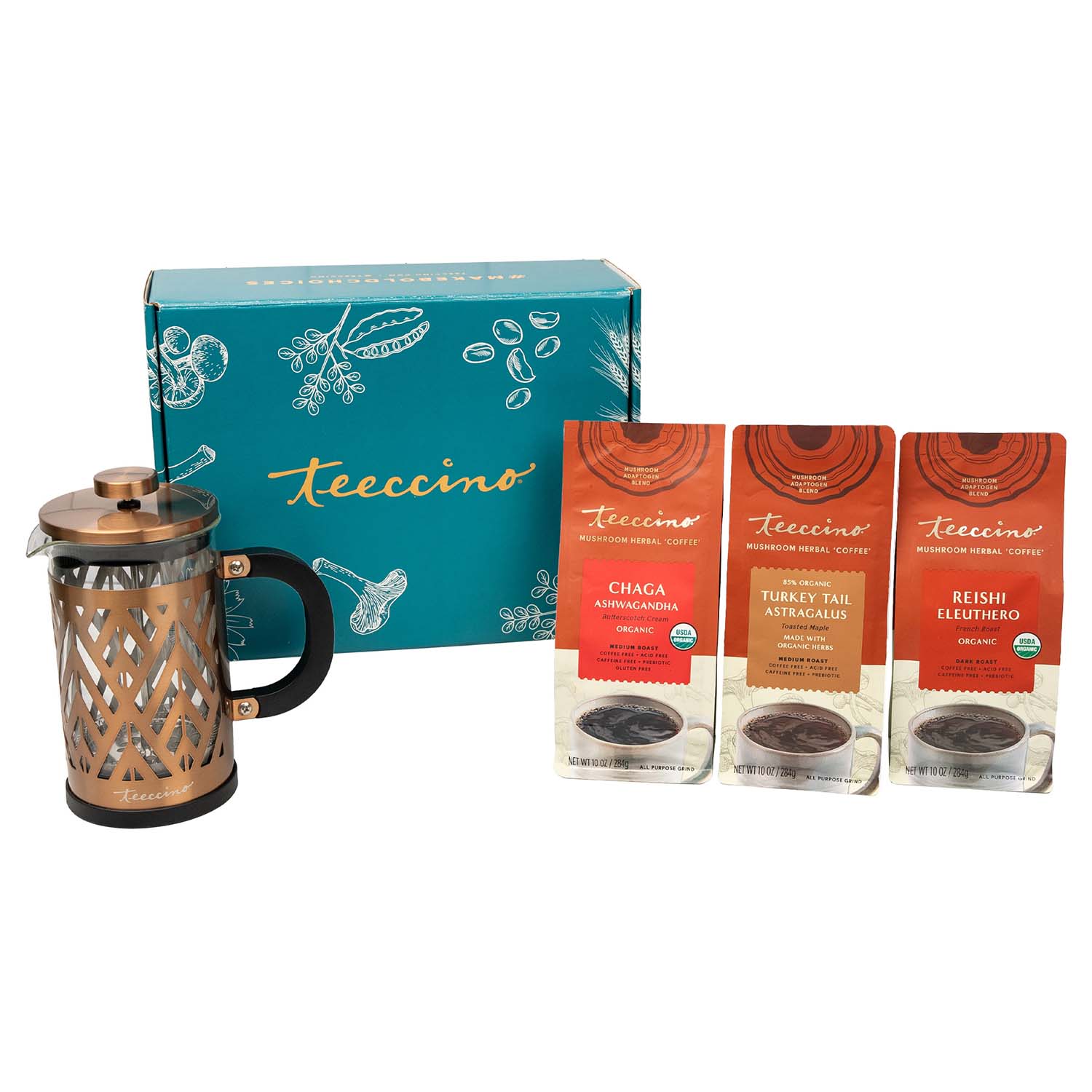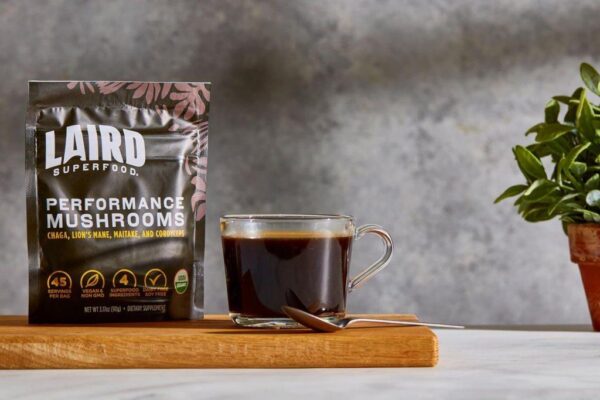Blog
Mushroom Tea and Your French Press
Switching out caffeine for mushroom tea offers many advantages, including natural energy increases, stress relief and an immune system boost. Making the switch can easily be accomplished at home with just your French press!
Fill a French press with ground chaga and loose leaf tea of your choice, pour hot water over them, and steep for 2 minutes before drinking or straining out of the cup.
Dried Mushrooms
Dried mushrooms are a mainstay in mushroom tea, offering numerous health benefits from stress reduction to better sleep to immune support. Plus, its flavor sets it apart from traditional black or green tea bags!
Homebrewing mushroom tea is the easiest and best way to experience its benefits, featuring various species in hot water with tea leaves and pre-mixed products or pre-packed sachets of both tea and mushrooms, making brewing convenient even on busy mornings. Powdered varieties available from Moon Juice’s Dusts, Reishi Tinctures, or Tamim Teas offer convenient powders which you can mix directly into smoothies, teas and juices; moon dusts contain Moon Juice dusts while Tamim teas carry Chaga powder for easy brewing at home!
If you’re making mushroom tea at home, using a French press is key to ensure the mushrooms stay submerged during brewing and don’t become crushed during the brew process. They can be found at most health food stores as well as online.
Mushrooms have long been used as part of traditional Eastern medicine. While you might not find them alongside cremini and portobellos at your grocery store, reishi or maitake mushrooms are commonly added to tonic teas that claim to treat everything from high stress levels and poor immunity systems to fatigue and sluggishness. Furthermore, medicinal mushrooms offer natural energy boosts without the jitters that accompany coffee consumption.
Reducing caffeine intake and tapping into the power of mushrooms is an exciting prospect, so here’s an amazing mushroom tea recipe you can whip up in your French press – great as an early morning boost or relaxing nightcap beverage! Enjoy!
Uncooked Grains
Whole grains offer essential nutrition in both raw and cooked form, from vitamins, minerals, antioxidants, carbohydrates (the body’s preferred energy source) to proteins. Their versatility makes them easy to incorporate into any meal for an enjoyable and nutritive meal experience. When eating raw grains, proper preparation can maximize their benefits by soaking, sprouting or fermenting in order to minimize antinutrients while making them more digestible and beneficial.
Cooking grains over an extended period is also vitally important, as this alters their structure and composition, making them more digestible for humans while at the same time eliminating harmful bacteria that may linger inside. Also, this process eliminates potentially harmful organisms which might threaten one’s health.
Some of the most popular whole grains include quinoa, amaranth and millet. Amaranth stands out among these options by being an all-in-one protein source with all essential amino acids present, while quinoa offers iron and magnesium, while millet is high in fiber while boasting more calcium than any other grain.
Add some whole grains to your mushroom tea French press for a variety of flavors and textures that won’t let you down! Create a satisfying grain salad by tossing quinoa, bulgur or farro with fresh vegetables, herbs and vinaigrette for an easy lunch option; or top your morning bowl of quinoa, buckwheat or amaranth with roasted vegetables, protein and honey drizzle for a tasty breakfast option. You could even add Turkey tail mushroom powder for extra digestive health benefits; this combination works to reduce belly fat while improving insulin sensitivity!
Tea
Tea is one of the world’s favorite beverages and has long been associated with various health benefits. People enjoy it both plain or combined into creative beverages like lattes. While coffee contains caffeine, most herbal teas don’t; thus mushrooms add additional adaptogenic and immune enhancing qualities to these herbal infusions.
Mushroom teas often combine various herbs and spices that enhance its flavor, such as cinnamon. You can even use a French press to extract as much nutrition from mushrooms as possible!
Before producing tea, the leaves must first be withered under shade to evaporate some of their water content and rolled either by hand or machine to create their desired shapes and reveal individual characteristics such as increased pliability and reduced fragility. After this step is completed, moisture content of the leaves is reduced down to 4-7% for final production of the cup of tea.
During the brewing process, rolled leaves are heated to an ideal temperature between 71-72 degrees Celsius to allow their antioxidants to bind with one another and maximize bioavailability, as well as avoid any loss of antibacterial compounds.
As your tea cools, inactive cellular material and spores of mushrooms are separated from their active components, allowing those active compounds to enter your system where they can work their magic.
Properly prepared turkey tail mushroom tea boasts an earthy sweetness. Enhancing it further with lemon, cinnamon or honey can bring additional dimension and add to its depth of flavor – providing a satisfying contrast against its rich mushroom blend base.
Mushroom tea has quickly become an increasingly popular trend among healthy cafes and supermarkets alike, while home brewers are quickly following suit. This beverage can help with everything from digestive issues to stress; its adaptogenic properties make it the perfect morning beverage to get you going during the day or an evening beverage to help unwind and relax after work.
Broth
Many of us may have come across recipes claiming health benefits that use “broth” and “stock” interchangeably, yet there are distinct differences between these cooking liquids. While broth and stock share similar qualities when it comes to their characteristics as cooking liquids, there are key distinctions between them.
Broth is an aromatic culinary liquid produced from simmering meat and vegetables in water for extended periods. This method extracts important minerals, vitamins, and other essential nutrients from bones and joints of animals and vegetables being cooked, giving us a deliciously nutritious dish!
Seasoned broth can be enjoyed both as-is and added to more complex recipes such as soup. Sips may be enjoyed as beverages, or used as an ingredient in dishes like risotto, grilled vegetables, Bolognese sauce and other filling meals.
Traditional broth is typically meat based, though vegetable-based broths also exist. The primary difference between stock and broth is that stock requires bones for flavor while broth does not; “stock” also refers to any form of stock without meat such as bouillon cubes or granules.
Mushrooms can add a rich, umami flavor while simultaneously strengthening our immune systems. Mushrooms contain polysaccharides which aid our bodies in fighting infections and inflammation.
Making mushroom tea using a French press can be accomplished by adding desired amount of dry mushrooms to the bottom of a glass container, then filling it with hot water and sealing with lid before slowly lowering plunger to extract mixture.
Mushroom tea is an effective way to enjoy the benefits of mushrooms without the caffeine found in coffee, providing an immunity boost or sleep aid throughout your day or before bed. Safe for both adults and children alike, mushroom tea contains no caffeine and is safe for both gastrointestinal tracts and liver functions; depending on its polysaccharides concentration some people find this is also an effective anti-inflammatory and may help lower blood pressure.





